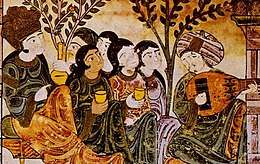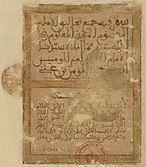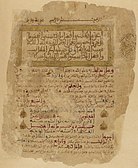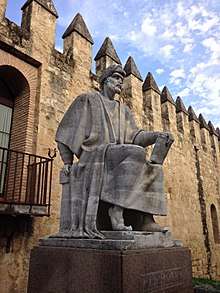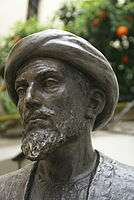Literature of al-Andalus
The literature of al-Andalus, also known as Andalusi literature (Arabic: الأدب الأندلسي, al-adab al-andalusī),[1][2] was produced in Al-Andalus, or Islamic Iberia, from the Muslim conquest in 711 to either the Catholic conquest of Granada in 1492 or the Expulsion of the Moors ending in 1614. Andalusi literature was written primarily in Arabic, but also in Hebrew, Judeo-Arabic, Aljamiado, and Mozarabic.
Abdellah Hilaat's World Literature Encyclopedia divides the history of Al-Andalus into two periods: the period of expansion, starting with the conquest of Hispania up to the first Taifa period, and the period of recession in which Al-Andalus was ruled by two major African empires: the Almoravid and the Almohad.[3]
Conquest
| History of Al-Andalus |
|---|
|
Muslim conquest (711–732) |
|
Umayyads of Córdoba (756–1031) |
|
|
First Taifa period (1009–1110) |
|
Almoravid rule (1085–1145) |
|
Second Taifa period (1140–1203) |
|
Almohad rule (1147–1238) |
|
Third Taifa period (1232–1287) |
|
Emirate of Granada (1238–1492) |
| Related articles |
Arabic literature in al-Andalus began with the Umayyad conquest of Hispania starting in the year 711. The 20th century Moroccan scholar of literature Abdellah Guennoun cites the Friday sermon of the Amazigh general Tariq ibn Ziyad to his soldiers upon landing in Iberia as a first example.[4]
The literature of the Muslim conquerors of Iberia, aside from the Quran, was limited to eastern strophic poetry that was popular in the early 7th century.[3] The content of the conquerors' poetry was often boasting about noble heritage, celebrating courage in war, expressing nostalgia for homeland, or elegy for those lost in battle, though all that remains from this period is mentions and descriptions.[3]
In contrast with the circumstances in the Visigothic invasion of Iberia, the Arabic that came with the Muslim invasion had the status of "a vehicle for a higher culture, a literate and literary civilization."[5] From the eighth to the thirteenth century, the non-Latin forms of intellectual expression were dominant in the area.[5]
Umayyad period (756-1031)
In his History of Arabic Literature, Hanna Al-Fakhoury cites two main factors as shaping Andalusi society in the early Umayyad period: the mixing of the Arabs with other peoples and the desire to replicate the Mashriq.[6] The bustling economy of al-Andalus allowed Al-Hakam I to invest in education and literacy; he built 27 madrasas in Cordoba and sent missions to the east to procure books to be brought back to his library.[6] Al-Fakhoury cites Reinhart Dozy in his 1881 Histoire des Musulmans d'Espagne: "Almost all of Muslim Spain could read and write, while the upper class of Christian Europe could not, with the exception of the clergy."[6] Cities—such as Córdoba, Seville, Granada, and Toledo—were the most important centers of knowledge in al-Andalus.[6]
On religion
The east was determined to spread Islam and protect it in distant Iberia, sending religious scholars, or ulamaa.[3] Religious study grew and spread, and the Iberian Umayyads, for political reasons, adopted the Maliki school of jurisprudence, named after the Imam Malik ibn Anas and promoted by Abd al-Rahman al-Awza'i.[3] A religious school was established, which published Malik's Muwatta.[3]
This school produced a number of notable scholars, prominent among whom was Ibn 'Abd al-Barr. Al-Andalus witnessed great deliberation in Quranic exegesis, or tafsir, from competing schools of jurisprudence, or fiqh.[3] Upon his return from the east, Baqi ibn Makhlad (817-889) unsuccessfully attempted to introduce the Shafi‘i school of fiqh, though Ibn Hazm (994-1064) considered Makhlad's exegesis favorable to Tafsir al-Tabari. The Zahiri school was, however, introduced by Ibn Qasim al-Qaysi, and further supported by Mundhir ibn Sa'īd al-Ballūṭī. It was also heralded by Ibn Hazm, a polymath at the forefront of all kinds of literary production in the 11th century, widely acknowledged as the father of comparative religious studies,[7][7] and who wrote Al-Fisal fi al-Milal wa al-Nihal (The Separator Concerning Religions, Heresies, and Sects).[3]
The Muʿtazila school and philosophy also developed in al-Andalus, as attested to in the book of Ibn Mura (931).[3]
On language
The study of language spread and was invigorated by the migration of the linguist Abu Ali al-Qali (967), who migrated from Baghdad to Cordoba and wrote a two-volume work entitled al-Amali based on his teachings at the Mosque of Córdoba.[3][8] He also authored a 5000-page compendium on language al-Bari' and an-Nawādir.[3] Some of his contemporaries were Qasim bin 'Abbūd ar-Riahi (968), Ibn 'Aasim (992), and Ibn al-Qūṭiyya (977).[3][9] Ibn Sidah (1066) wrote Al-Mukhaṣṣaṣ and Al-Muḥkam wa-al-Muḥīt al-Aʻtham.[3]
On history
At first, Andalusi writers mixed history with legend, as Abd al-Malik Ibn Habib did.[3]
They later wrote annals in the format of Al-Tabari's text History of the Prophets and Kings, which Ibn Sa'd (980) complemented with contemporary annals.[3] Most historians were interested in the history of Hispania, tracing the chronology of its history by kings and princes.[3] Encyclopedias of people also became popular, such as encyclopedias of judges, doctors, and writers.[3] The most important of these was told the history of al-Andalus from the Islamic conquest to the time of the author, as seen in the work of the Umayyad court historian and genealogist Ahmed ar-Razi (955) News of the Kings of al-Andalus (أخبار ملوك الأندلس وخدمتهم وغزواتهم ونكباتهم) and that of his son Isa, who continued his father's work and whom Ibn al-Qūṭiyya cited.[10][11] ar-Razi was also cited by Ibn Hayyan in al-Muqtabis.[3] The most important historical work of this period was Said al-Andalusi's Tabaqat ul-Umam, which chronicled the history of the Greeks and the Romans as well.[3]
On geography
Among the prominent writers in geography—besides Aḥmad ibn Muḥammad ibn Mūsa al-Rāzī, who described al-Andalus with great skill—there was Abū ʿUbayd al-Bakri (1094).[3]
On math and astronomy
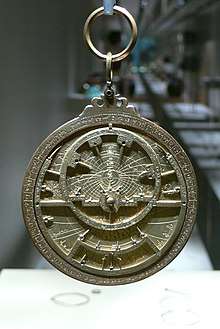
Writing in math and astronomy flourished in this period with the influence of Maslama al-Majriti (1007), who developed the work of Ptolemy and al-Khwarizmi.[3] Ibn al-Saffar wrote about the astrolabe and influenced European science into the 15th century.[12] Ibn al-Samh was a mathematician who also wrote about astrolabes.[13]
On medicine and agriculture
Works in medicine and agriculture also flourished under Abd al-Rahman III. Among writers in these topics there were Al-Zahrawi (1013).[3]
Ibn al-Kattani, also known as al-Mutatabbib, wrote about medicine, philosophy, and logic.[14]
Literature
The collection Al-ʿIqd al-Farīd by Ibn Abd Rabbih (940) could be considered the first Andalusi literary work, though its contents relate to the Mashriq.[3]
Muhammad ibn Hani al-Andalusi al-Azdi, a North African poet, studied in al-Andalus.[15]
Muwashshah
From around the 9th century, the Arab and Hispanic elements of al-Andalus began to coalesce, giving birth to a new Arab literature, evident in the new poetic form: the muwashshah.[3]
In the beginning, muwashshah represented a variety of poetic meters and schemes, ending with a verse in Ibero-Romance.[3] It marked the first instance of language mixing in Arab poetry as well as the syncretism of Arab and Hispanic cultures.[3] The muwashshah remained sung in Standard Arabic although its scheme and meter changed and the Ibero-Romance ending was added.[3] Some famous examples include "Lamma Bada Yatathanna" and "Jadaka al-Ghaith".[16] In spite of its widespread popularity and its favorability among Mashreqi critics, the muwashshah remained a form inferior to classical Arabic forms that varied only minimally in the courts of the Islamic west, due to the folksy nature of the muwashshah.[3]
The muwashshah would typically end with a closing stanza, or a kharja, in a Romance language or Arabic vernacular—except in praise poems, in which the closing stanza would also be in Standard Arabic.[6]
The muwashshah has gained importance recently among Orientalists because of its connection to early Spanish and European folk poetry and the troubadour tradition.[3]
Eastern influence
Andalusi literature was heavily influenced by Eastern styles, with court literature often replicating eastern forms.[17] Under Abd al-Rahman II, came Ziryab (857)—the mythic poet, artist, musician and teacher—from the Abbasid Empire in the East.[3] He gave Andalusi society Baghdadi influence.
The qiyān were a social class of non-free women trained as entertainers.[18] The qiyān brought from the Abbasid East were conduits of art, literature, and culture.[18]
Among the Mashreqi poets most influential in the Maghreb was Al-Mutanabbi (965), whose poetry was commented on by al-A'lam ash-Shantamari, Ibn al-Iflili, and Ibn Sidah.[3] The court poets of Cordoba followed his footsteps in varying and mastering their craft.[3] The maqamas of the Persian poet Badi' al-Zaman al-Hamadani were also embraced in al-Andalus, and influenced Ibn Malik, Ibn Sharaf, and Ibn al-Ashtarkuwi as-Saraqusti.[19][17] The maqama known as al-Maqama al-Qurtubiya, attributed to Al-Fath ibn Khaqan, is notable as it is a poem of invective satirizing Ibn as-Sayid al-Batalyawsi.[17] According to Jaakko Hämeen-Anttila, the use of the maqama form for invective appears to be an Andalusi innovation.[17]
Court poetry followed tradition until the 11th century, when it took a bold new form: the Umayyad caliphs sponsored literature and worked to gather texts, as evidenced in the library of Al-Hakam II.[3] As a result, a new school of court poets appeared, most important of whom was al-Muṣħafi (982).[3] However, urban Andalusi poetry started with Ibn Darraj al-Qastalli (1030), under Caliph al-Mansur, who burned the library of Al-Hakam fearing that science and philosophy were a threat to religion.[3] Sa'id al-Baghdadi and Yusuf bin Harun ar-Ramadi were among the most prominent of this style and period.[3]
Ibn Shahid led a movement of poets of the aristocracy opposed to the folksy muwashshah and fanatical about eloquent poetry and orthodox Classical Arabic.[3] He outlined his ideas in his book at-Tawabi' waz-Zawabi' (التوابع والزوابع), a fictional story about a journey through the world of the Jinn.[3][20] Ibn Hazm, in his analysis of chaste poetry in The Ring of the Dove, is considered a member of this school, though his poetry is of a lower grade.[3]
Judeo-Andalusi literature
Jewish writers in al-Andalus were sponsored by courtiers such as Hasdai ibn Shaprut (905-975) Samuel ibn Naghrillah (993-1056). Jonah ibn Janah (990-1055) wrote a book of Hebrew.[21]
Samuel ibn Naghrillah, Joseph ibn Naghrela, and Ibn Sahl al-Isra'ili wrote poetry in Arabic, but most Jewish writers in al-Andalus—while incorporating elements such as rhyme, meter, and themes of classical Arabic poetry—created poetry in Hebrew.[21] In addition to a highly regarded corpus of religious poetry, poets such as Dunash ben Labrat, Moses ibn Ezra, and Solomon ibn Gabirol wrote about praise poetry about their Jewish patrons, as well and on topics traditionally considered non-Jewish, such as "carousing, nature, and love" as well as poems with "homoerotic themes.[21]
Bahya ibn Paquda wrote Duties of the Heart in Judeo-Arabic in Hebrew script around 1080, and Judah ha-Levi wrote the Book of Refutation and Proof on Behalf of the Despised Religion in Arabic around 1140.[21]
Joseph ben Judah ibn Aknin was polymath and prolific writer born in Barcelona and moved to North Africa under the Almohads, settling in Fes.[22]
Petrus Alphonsi was an Andalusi Jew who converted to Christianity under Alfonso I of Aragon in the year 1106.[5] He wrote Dialogi contra Iudaeos, an imaginary conversation between a Christian and a Jew, and Disciplina Clericalis, a collection of Eastern sayings and fables in a frame-tale format present in Arabic literature such as Kalila wa Demna.[23][5] He also translated Al-Khawarizmi's tables and advocated for Arabic sciences, serving as a bridge between cultures at a time when Christian Europe was opening up to "Arabic philosophical, scientific, medical, astronomical, and literary cultures."[5]
First Taifa period (1031-1086)

The collapse of the caliphate and the beginning of the Taifa period, did not have a negative impact on poetic production.[3] In fact, poetry in al-Andalus reached its apex at this time.[3] Ibn Zaydun of Cordoba, author of the Nūniyya of Ibn Zaydūn, was famously in love with Wallada bint al-Mustakfi, who inspired the poets of al-Andalus as well as those of the Emirate of Sicily, such as Ibn Hamdis.[3] Ibn Sharaf of Qairawan and Ibn Hamdün (1139) became famous in the court of Al-Mu'atasim of Almería, while Abū Isḥāq al-Ilbirī and Abd al-Majid ibn Abdun stood out in Granada.[3]
Abu al-Hakam al-Kirmani was a doctor, mathematician, and philosopher from Cordoba; he is also credited with first bringing Brethren of Purity to al-Andalus.[25]
Al-Mu'tamid ibn Abbad, poet king of the Abbadid Taifa of Seville, was known as a generous sponsor of the arts.[24] Ibn Hamdis of Sicily joined al-Mu'tamid's court.[26]
Almoravid period (1086-1150)
Literature flourished in the Almoravid period. The political unification of Morocco and al-Andalus under the Almoravid dynasty rapidly accelerated the cultural interchange between the two continents, beginning when Yusuf Bin Tashfiin sent al-Mu'tamid Bin Abbad into exile in Tangier and ultimately Aghmat.[27][28]
In the Almoravid period two writers stand out: the religious scholar and judge Ayyad ben Moussa and the polymath Ibn Bajja (Avempace). Ayyad is known for having authored Kitāb al-Shifāʾ bīTaʾrif Ḥuqūq al-Muṣṭafá.[29]
Scholars and theologians such as Ibn Barrajan were summoned to the Almoravid capital in Marrakesh where they underwent tests.[30]
Poetry
Ibn Zaydun, al-Mu'tamid, and Muhammad ibn Ammar were among the more innovative poets of al-Andalus, breaking away from traditional Eastern styles.[6]
The muwashshah was an important form of poetry and music in the Almoravid period. Great poets from the period are mentioned in anthologies such as Kharidat al Qasar,[31] Al Mutrib, and Mu'jam as-Sifr.[32]
In the Almoravid period, in which the fragmented taifas were united, poetry faded as they were mostly interested in religion.[3] Only in Valencia could free poetry of the sort that spread in the Taifa period be found, while the rulers in other areas imposed traditional praise poetry on their subjects.[3] In Valencia, there was poetry of nature and ghazal by Ibn Khafaja and poetry of nature and wine by Ibn az-Zaqqaq.[3]
History
The historians Ibn Hayyan, Al-Bakri, Ibn Bassam, and al-Fath ibn Khaqan all lived in the Almoravid period.
Almohad period (1150-1230)
The Almohads worked to suppress the influence of Maliki fiqh—even publicly burning copies of Muwatta Imam Malik and Maliki commentaries.[33] They sought to disseminate the doctrine of Ibn Tumart, author of E'az Ma Yutlab (أعز ما يُطلب The Most Noble Calling), Muhadhi al-Muwatta' (محاذي الموطأ Counterpart of the Muwatta), and Talkhis Sahih Muslim (تلخيص صحيح مسلم Compendium of Sahih Muslim).[33]
Almohad reforms
Literary production continued despite the devastating effect the Almohad reforms had on cultural life in their domain. Almohad universities continued the knowledge of preceding Andalusi scholars as well as ancient Greco-Roman writers; contemporary literary figures included Ibn Rushd (Averroes), Hafsa bint al-Hajj al-Rukuniyya, Ibn Tufail, Ibn Zuhr, Ibn al-Abbar, Ibn Amira and many more poets, philosophers, and scholars. The abolishment of the dhimmi status further stifled the once flourishing Jewish Andalusi cultural scene; Maimonides went east and many Jews moved to Castillian-controlled Toledo.[35]
In the Almohad period, the poets Ibn Sahl of Seville and ar-Rusafi al-Valenci (1177) appeared.[3]
Ibn Tufail and Ibn Rushd (Averroes) were considered the main philosophers of the Almohad Caliphate and were patronized by the court.[36] Ibn Tufail wrote the philosophical novel Hayy ibn Yaqdhan, which would later influence Robinson Crusoe.[37] Ibn Rushd wrote his landmark work The Incoherence of the Incoherence responding directly to Al-Ghazali's work The Incoherence of the Philosophers.[36]
Sufism
With the continents united under empire, Abu Madyan brought the Andalusi form of Sufism, which combined ascetic mysticism and the study of law, to North Africa.[38] Ibn Arabi, venerated by many Sufis as ash-Sheikh al-Akbar, was born in Murcia and studied in Seville.[39] His works, such as the Meccan Revelations, were highly influential.[38][39]
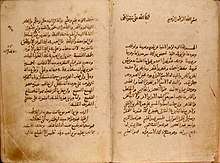
When literary figures sensed the decline of Andalusi poetry, they began to gather and anthologize: Ibn Bassam wrote Dhakhīra fī mahāsin ahl al-Jazīra, Al-Fath ibn Khaqan wrote " Qalā'id al-'Iqyān" (قلائد العقيان), Ibn Sa'id al-Maghribi wrote al-Mughrib fī ḥulā l-Maghrib and Rayat al-mubarrizin wa-ghayat al-mumayyazin.[3] Up until the departure of the Muslims from al-Andalus, there were those who carried the standard of the muwashshah, such as Al-Tutili (1126) and Ibn Baqi (1145), as well as those such as Ibn Quzman (1159) who elevated zajal to the highest of artistic heights.[3] The zajal form experienced a rebirth thanks to Ibn Quzman.[3]
Ibn Sab'in was a Sufi scholar from Ricote who wrote the Sicilian Questions in response to the inquiries of Frederick II of Sicily.[40]
Female poets
Hamda bint Ziyad al-Muaddib was a 12th-century poet from Guadix known as the "Al-Khansa of al-Andalus."[41] Hafsa bint al-Hajj al-Rukuniyya was a poet from Granada.[42] She later worked for the Almohad caliph Abu Yusuf Yaqub al-Mansur, educating members of his family.[42]
Biography
Biographical books spread after Qadi Ayyad, and among the famous biographers there were Ibn Bashkuwāl, Abu Ja'far Ahmad ibn Yahya al-Dabbi, Ibn al-Abbar, and Ibn Zubayr al-Gharnati.[3]
On history
Ibn Sa'id al-Maghribi wrote Al-Mughrib fī ḥulā l-Maghrib citing much of what was published in the field beforehand.[3]
On geography and travel writing
Muhammad al-Idrisi stood out in geography and in travel writing: Abu Hamed al-Gharnati, Ibn Jubayr, and Mohammed al-Abdari al-Hihi.[3]
Third Taifa period
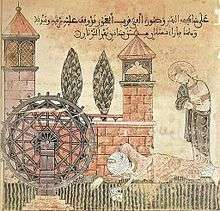
Abu al-Baqa ar-Rundi wrote the qasida Elegy for al-Andalus in 1267.[43]
In the 12th and 13th centuries, the sciences—such as mathematics, astronomy, pharmacology, botany, and medicine—flourished.
Hadith Bayad wa Riyad is a 13th-century love story and one of 3 surviving illuminated manuscripts from al-Andalus.[44]
Arabic influenced Spanish and permeated its vernacular forms. New dialects formed with their own folk literature that is studied for its effects on European poetry in the Middle Ages, and for its role in Renaissance poetry. Ramon Llull drew extensively from Arabic sciences, and first wrote his apologetic Book of the Gentile and the Three Wise Men in Arabic before Catalan and Latin.[5][45]
The agriculturalist Ibn al-'Awwam, active in Seville in the late 12th century, wrote Kitab al-Filaha, considered the most comprehensive medieval book in Arabic on agriculture.[46] Ibn Khaldun considered it a revision of Ibn Wahshiyya's Nabataean Agriculture.[47]
Nasrid period (1238-1492)
.jpg)
According to Salah Jarrar, the "bulk of [literature in the Nasrid period] dealt and was closely involved with the political life of the state. The conflict between the last Muslim state in Spain and the Spanish states seems to have dominated every aspect of life in Granada."[48]
The polymath and statesman Lisān ad-Dīn Ibn al-Khatīb is regarded as one of the most significant writers of the Nasrid period, covering subject such as "history, biography, the art of government, politics, geography, poetics, theology, fiqh, Sufism, grammar, medicine, veterinary medicine, agriculture, music, and falconry."[5][3] The last of the poets of al-Andalus before the fall of Granada was Ibn Zamrak.[3]
As for prose, which began in al-Andalus with Ibn Shahid and Ibn Hazm, it quickly leaned toward replicating the prose of the Mashreq.[3] Siraj al-Muluk by Abu Bakr al-Turtushi, as well as the Al-Balawi Encyclopedia and the list of maqamat that replicated those of Al-Hariri of Basra, such as those of Ahmed bin Abd el-Mu'min of Jerez (1222).[3] The Almohads encouraged religious and scientific composition: in the religious sciences, Ibn Essam (1426) wrote at-Tuhfa (تحفة الحكام في نكت العقود والأحكام) and Ibn as-Sayid of Badajoz wrote about language.[3] The works of some writers, such as the grammarian Ibn Malik and Abu Hayyan al-Gharnati, reached the Mashreq and had an influence there.[3]
Andalusi literature after Catholic conquest
Suppression
After the Fall of Granada, Cardinal Francisco Jiménez de Cisneros oversaw the forced mass conversion of the population in the Spanish Inquisition and the burning of Andalusi manuscripts in Granada.[49][50] In 1526, Charles V (Charles I of Spain)—issued an edict against "heresy" (e.g. Muslim practices by "New Christians"), including the use of Arabic. The Moriscos managed to get this suspended for forty years by the payment of a large sum (80,000 ducados).[51] King Philip II of Spain's Pragmatica of 1 January 1567 finally banned the use of Arabic throughout Spain, leading directly to the Rebellion of the Alpujarras (1568–71).[52]
Resistance
After Catholic conquest, Muslims in Castile, Aragon and Catalonia often used Castilian, Aragonese and Catalan dialects instead of the Andalusi Arabic dialect. Mudéjar texts were then written in Castilian and Aragonese, but in Arabic script.[53] One example is the anonymous Poema de Yuçuf, written in Aragonese but with Aljamiado Arabic script.[54] Most of this literature consisted of religious essays, poems, and epic, imaginary narratives. Often, popular texts were translated into this Castilian-Arabic hybrid.[55]
Much of the literature of the Moriscos focused on affirming the place of Arabic-speaking Spaniards in Spanish history and that their culture was integral to Spain.[56] A famous example is la Verdadera historia del rey don Rodrigo by Miguel de Luna.[57]
References
- "Popular Andalusi literature and the Arthurian tradition in the Iberian Peninsula". ARCADE. Retrieved 2020-08-09.
- "The Study of al-Andalus — Michelle M. Hamilton, David A. Wacks". www.hup.harvard.edu. Retrieved 2020-08-09.
- هيلات, عبدالله خليل (2012-01-01). الموسوعة الأدبية العالمية (in Arabic). Al Manhal. ISBN 9796500028231.
- كنون، عبد الله (1908-1989) المؤلف (2014). النبوغ المغربي في الأدب العربي. دارالكتب العلمية،. ISBN 978-2-7451-8292-0. OCLC 949484459.
- Menocal, María Rosa; Scheindlin, Raymond P.; Sells, Micheal (2012). The literature of Al-Andalus. Cambridge University Press. ISBN 978-1-139-17787-0. OCLC 819159086.
- الفاخوري, حنا (2014-01-01). تاريخ الأدب العربي (in Arabic). DMC.
- Joseph A. Kechichian, A mind of his own. Gulf News: 21:30 December 20, 2012.
- "ملف:أمالي القالي والذيل والنوادر والتنبيه.pdf - ويكي مصدر" (PDF). ar.wikisource.org. Retrieved 2020-06-13.
- texte, MUḤAMMAD ibn ʿUmar Ibn al-Qūṭīya Auteur du (1501–1600). Deux textes historiques sur al-Andalus.CS1 maint: date format (link)
- "تطور الفكر التاريخي في الأندلس - بقلم الدكتور أنور محمود زناتي". مقالات دار عين. 2014-08-25. Retrieved 2020-08-02.
- Echevarría Arsuaga, Ana (2016-09-13). "al-Razi". Encyclopedia of the Medieval Chronicle.
- Glick, Thomas F.; Livesey, Steven; Wallis, Faith (2014-01-27). Medieval Science, Technology, and Medicine: An Encyclopedia. Routledge. ISBN 978-1-135-45932-1.
- "Ibn al-Samh". islamsci.mcgill.ca. Retrieved 2020-08-04.
- "Islamic Medical Manuscripts: Bio-Bibliographies - I". www.nlm.nih.gov. Retrieved 2020-08-04.
- Dachraoui, F. (2012-04-24). "Ibn Hāniʾ al-Andalusī". Encyclopaedia of Islam, Second Edition.
- بسيوني, إعداد: د محمد سبيل وداليا. "الموشحات.. فاتنة نائمة يوقظها جدل العشاق - ملفات البيان - البيان". www.albayan.ae (in Arabic). Retrieved 2020-08-03.
- Hämeen-Anttila, Jaakko (2002). Maqama: A History of a Genre. Otto Harrassowitz Verlag. ISBN 978-3-447-04591-9.
- "The Qiyan (Singing Slave Girls) of Medieval Muslim Spain | Center for Middle East Studies". watson.brown.edu. Retrieved 2020-08-06.
- الفهد, محمد سطام. "المقامات اللزومية - مسارات - كتب - البيان". www.albayan.ae (in Arabic). Retrieved 2020-08-14.
- "التوابع والزوابع" (in Arabic). Retrieved 2020-08-01.
- Zohar, Zion (June 2005). Sephardic and Mizrahi Jewry: From the Golden Age of Spain to Modern Times. NYU Press. ISBN 978-0-8147-9706-8.
- Cohn-Sherbok, Lavinia; Cohn-Sherbok, Dan (2014-03-05). Medieval Jewish Philosophy: An Introduction. Routledge. ISBN 978-1-136-78833-8.
- Palmén, Ritva (2016-11-24). "Agreement in Conflict: Peter Alfonsi's Dialogi contra Iudaeos and the Idea of Recognition". Medieval Encounters. 22 (5): 540–564. doi:10.1163/15700674-12342237. ISSN 1570-0674.
- "المعتمد بن عباد: الشاعر العاشق والملك الضائع". إضاءات (in Arabic). 2015-03-02. Retrieved 2020-08-06.
- الزركلي, خير الدين. الأعلام - ج 5 : علي بن محمد - محمد بن أحمد (in Arabic). IslamKotob.
- "زمن العرب في صقلية.. رحلة الشعر من ظلال الأمراء إلى بلاط النورمان". www.aljazeera.net (in Arabic). Retrieved 2020-08-06.
- "دعوة الحق - المعتمد بن عباد في المغرب". habous.gov.ma. Retrieved 2020-02-05.
- Raymond P. Scheindlin, ed. (1974). Forme and Structure in the Poetry of Al-Muʿtamid Ibn ʿAbbād. Brill Archive. p. 24. ISBN 90-04-03890-6.
- ʿA'isha Bint ʿAbdurrahman Bewley, Muhammad Messenger of Allah: ash-Shifa' of Qadi ʿIyad (Granada: Madinah Press, 1992)
- "دعوة الحق - دراسات في الأدب المغربي -6- ب: الأوضاع الثقافية والأديبة في عهد المرابطين". www.habous.gov.ma. Retrieved 2020-08-03.
- Imad al-Din Muhammad ibn Muhammad Katib al-Isfahani, Kharidat al-qasr wa-jaridat al-asr: Fi dhikr fudala ahl Isfahan (Miras-i maktub)
- cited in: Mohammed Berrada, La Grande Encyclopédie du Maroc, 1987, p. 41
- Bongianino, Umberto (Feb 8, 2018). The Ideological Power of Some Almohad Illuminated Manuscripts (Lecture).
- https://plato.stanford.edu/entries/maimonides-islamic/
- Sijelmassi, Mohamed (1987). ذخائر مخطوطات الخزانة الملكية بالمغرب: (Bibliothèque al-Hassania) (in French). www.acr-edition.com. ISBN 978-2-86770-025-5.
- Press, Oxford University (2010-05-01). Muslim Spain: Oxford Bibliographies Online Research Guide. Oxford University Press, USA. ISBN 978-0-19-980407-8.
- "The Islamic Roots Of Science Fiction". io9. Retrieved 2020-08-05.
- Bennison, Amira K. (2016-08-01). Almoravid and Almohad Empires. Edinburgh University Press. ISBN 978-0-7486-4682-1.
- "Ibn al-ʿArabī | Muslim mystic". Encyclopedia Britannica. Retrieved 2020-08-03.
- Akasoy, Anna Ayşe (2008-05-28). "Ibn Sab'īn's Sicilian Questions: the Text, its Sources, and their Historical Context". Al-Qanṭara. 29 (1): 115–146. doi:10.3989/alqantara.2008.v29.i1.51. ISSN 1988-2955.
- al-Udhari, Abdullah (2017-01-16). Classical Poems by Arab Women: A Bilingual Anthology. Saqi Books. ISBN 978-0-86356-930-2.
- Meri, Josef W. (2005-10-31). Medieval Islamic Civilization: An Encyclopedia. Routledge. ISBN 978-1-135-45603-0.
- Khalidi 2016, p. 14
- Dodds, Jerrilynn Denise. Al-Andalus the art of Islamic Spain ; [Exhibition Al-Andalus - The Art of Islamic Spain, held at the Alhambra, Granada, (March 18 - June 7, 1992), and the Metropolitan Museum of Art, New York (July 1 - September 27, 1992)]. ISBN 0-87099-636-3. OCLC 948572682.
- Badia, Lola; Suñol, Joan Santanach i; Santanach, Joan; Soler, Albert; Llopart, Albert Soler i (2016). Ramon Llull as a Vernacular Writer: Communicating a New Kind of Knowledge. Boydell & Brewer. ISBN 978-1-85566-301-5.
- "The Filāḥa Texts Project". www.filaha.org. Retrieved 2020-08-03.
- Ruska, J. (2012-04-24). "Ibn al-ʿAwwām". Encyclopaedia of Islam, First Edition (1913-1936).
- Jarrar, Salah Mo'hd Ma'hd. Literature and literary life in Nasrid Granada (1238-1492) and their relation to state politics. OCLC 1124378288.
- "Francisco, Cardinal Jiménez de Cisneros | Spanish cardinal". Encyclopedia Britannica. Retrieved 2020-08-06.
- "CENSORSHIP AND BOOK PRODUCTION IN SPAIN DURING THE AGE OF THE INCUNABULA". www.lehman.edu. Retrieved 2020-08-06.
- Lea, pp. 215-6
- Lea, p.227
- "Aljamiado | David A. Wacks". davidwacks.uoregon.edu. Retrieved 2019-03-09.
- Corroto, Paula (2019-06-04). "El 'Cantar de Mío Cid' se expone por primera vez durante 15 días tras seis siglos de encierro". elDiario (in Spanish). Retrieved 2020-08-03.
- "Mudejar | Spanish Muslim community". Encyclopedia Britannica. Retrieved 2019-03-09.
- Harsolia, Khadija Mohiuddin (2015). Captivity, Confinement and Resistance in Mudéjar and Morisco Literature (Thesis). UC Riverside.
- "Apunte biográfico sobre Miguel de Luna, Granada, c. 1545-1615. Elaborado por Luis Fernando Bernabé Pons - Literatura de mudéjares y moriscos". Biblioteca Virtual Miguel de Cervantes (in Spanish). Retrieved 2020-08-03.
